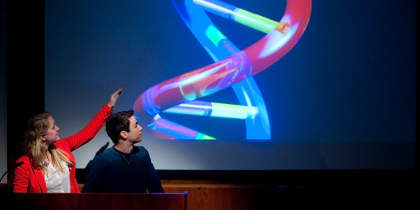
September 29, 2005, by Teaching at Nottingham
Dealing with information overload: student teach thy self
Ian Spendlove: “The Biomedical Sciences are subjects that are or appear to be heavily dependent on a large volume of information with an apparent emphasis on facts and content. Traditional didactic teaching approaches are common practice in these subjects. In order to address the potential for information overload, avoid student disengagement and stave off embarrassing catatonic states alternative teaching approaches were explored.
“Teaching of postgraduate courses in the science disciplines is aimed at development of a deeper understanding of concepts with a reasonable level of depth of knowledge. The long term goal is to promote student engagement in a content-rich subject. This was initiated by selecting a small subtopic which was briefly covered in lectures. The aim was to set learning objectives for small groups of students, provide them with guidance and direction and set the objective of delivering a short presentation to their peers. This resulted in positive feedback from the students.
With comments including:
‘having to give a presentation meant I had to learn the subject well’ and
‘can’t we do this instead of sitting through 3 hour lectures’.
“It was decided to modify the approach of delivering a “content rich” research topic and reconfigure this to reduce the amount of didactic teaching. By delivering lectures based on key concepts of a subject area, supplemented with worked examples, establish a framework. Then combining small group and collaborative / peer-learning assignments with a defined learning outcomes, groups would research a sub-topic, write a series of notes / handouts and present the sub-topic as a micro lecture with defined learning objectives to the class for assessment.
“The primary aim is to promote engagement of students and a deeper understanding of a content rich subject area. This is to be achieved in two ways; Reduce the amount of didactic teaching of content rich material, replacing the content with teaching of a framework with defined examples. Set small group assignments with clear learning outcomes, based on the previously taught framework. Each of the sub-topics should collectively reinforce the concept framework and broaden the knowledgebase of the students without the distraction of information overload.
“The rationale will appear to reduce the volume of by providing defined conceptual framework. This should then be reinforced by assigning a defined a sub-topic to research. This should strengthen each groups understanding through research of the subject and ensure comprehension by requiring the group to present the sub-topic as a lecture. This is a long-term initiative extending an approach already taken and based on positive feedback from students. The study will be evaluated each year based on student feedback and performance. This may in turn result in further changes in our approach.
“By developing a model for teaching a content rich curriculum it is hoped that an improved teaching / learning experience and promote a more active participation in the learning process.”
Paper presented at the University’s Seventh Learning & Teaching conference (September, 2005).
Dr Ian Spendlove
Lecturer and Course Director for MSc Oncology
School of Molecular Medical Sciences
No comments yet, fill out a comment to be the first

Leave a Reply